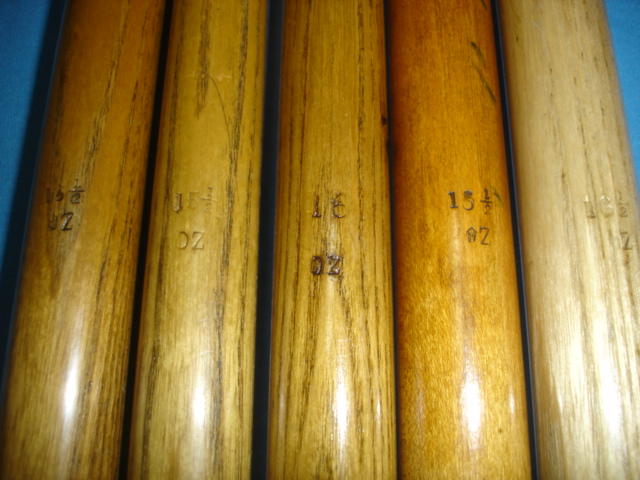© 2007 - Gordon Radford
The Cue Collector - Articles about Collecting Cues
PERADON WEIGHT STAMPS by Andy Hunter and Gordon Radford
Peradon & Co
Peradon & Co was founded by Leopold Peradon in 1885 at his home in Linacre Road, Willesden. The company was different from most other billiards firms in that it was a specialist or dedicated cue manufacturer. It didn't make billiards or snooker tables like other major billiards firms such as Burroughes & Watts or E.J. Riley Limited.
For most of its life, Peradon & Co appears to have been a wholesaler of cues rather than a retailer of cues. In other words, Peradon & Co does not appear to have sold cues directly to the public but, rather, seems to have supplied the trade, which then on-sold Peradon-manufactured cues to the general public.
We have seen Peradon cues advertised by different billiards firms in their catalogues and it is certainly not uncommon to see Peradon cues with a second badge carrying the name of a retailer. Most commonly, the second badge is a small round badge set into the flat of the cue, just above the main badge.
A common example is Ashcroft & Co of Liverpool, who seem to have sold Peradon cues from at least the 1920s. Other examples include EA Clare & Son, Murtons, W.A. Camkin and Howarth Nuttall.
It is most likely that many smaller firms would have turned to Peradon for supplies of cues in the aftermath of the First World War when suitable timber, not to mention skilled labour, would have been much harder to find.
The earliest Peradon cues were plain ash but these were soon followed by one point, two point and then four point handspliced cues and, later still, solid butted four point machine spliced cues. In the period between 1900 and 1914, before the First World War, Peradon & Co also operated a factory at Beauvais, in France.
In the 1930s, Peradon & Co entered the export trade and began exporting cues to all corners of the British Commonwealth. Many of the cues sold by Empire firms, such as Alcock & Co and Heiron & Smith in Australia and Barton McGill in New Zealand, were actually made under contract by Peradon & Co in England. At one time, Peradon & Co were probably the largest cue manufacturers in the British Commonweath and many antique cues seen today are, in fact, Peradon cues.
In the 1950s, Peradon acquired MacMorran & Co, Weildings (Billiards) Limited and also Nidds of Kentish Town. The acquitision of MacMorran & Co lead to the development of the "Permac" range of cues, which included the Permac Olympic cue and the Permac Champion cue.
According to the billiards historian, Norman Clare, the result of these acquisitions was that Peradon & Co became the only surviving dedicated manufacturer of billiards cues in entire British Commonwealth.
In 1977, Peradon & Co was purchased by E.L. Fletcher and Son Limited and the company was renamed "Peradon & Fletcher". E.L. Fletcher and Son Limited had previously been acquired by E.A. Clare Limited in 1972.
Peradon Weight Stamps
There are at least seven different types of weight stamps which appear on Peradon cues. These are not as useful to a collector as the weight stamps found on Burroughes & Watts cues or Riley cues because, unlike those weight stamps, the Peradon weight stamps are not necessarily unique to distinct eras. Instead, there are groups of weight stamps that seem to have been used concurrently.
Nevertheless, a knowledge of Peradon weight stamps is useful. It does allow some dating of cues but, more importantly, it can help to verify whether a cue is an original Peradon cue or a replica or whether a badge has been taken from an original Peradon cue and attached to a different cue.
The Earliest Peradon Weight Stamps - circa 1890s to early 1900s
The earliest Peradon cues to carry badges appear to have been made in the 1890s. Two types of weight stamp appear to have been used on these cues.
The first type of Peradon weight stamp is shown in the picture to the right. It has the words "OZ" above the manufactured weight of the cue.
We have seen this type of weight stamp on early Peall Record Cues, which commemorate the break of 3304 made by W.J. Peall in November 1890.
The Peall Record Cues were made over a long period of time, probably from around 1891 through to the 1930s, when Walter Lindrum made his phenomenal world record breaks of 3262 and 4137. This weight stamp can help to distinguish earlier Peall Record Cues from later Peall Record Cues.
During much the same era, a second type of weight stamp also appears to have been used on some Peradon cues. This is shown in the picture to the right. It has the letters "OZ" arranged, one on top of the other, with the manufactured weight of the cue below the letters.
This type of weight stamp appears to have been used on presentation cues made by Peradon & Co.
For instance, Oxford University (and, later, Cambridge University) held billiards competitions in which the first prize was the winner's choice of cue. The Oxford competition was known as the Cue Competition. These cues were almost always pear-shafted cues because, at the time, in the late 1890s, pear shafts were widely regarded as the best shafts.
These presentation cues are distinguished by the weight stamp shown in the picture to the right. Notably, the cue shown in that picture is, in fact, a pear-shafted cue.
We have seen this type of weight stamp on a Peall Record Cue and also on an A.W. Gamage Referee Cue sold recently on eBay.
Peradon Weight Stamps - early 1900s to 1930s
In the period from the early 1900s through to the mid-1930s, the two early Peradon weight stamps appear to have been superseded by a single weight stamp. This is shown in the picture to the right. In this weight stamp, the manufactured weight of the cue appears above the letters "OZ".
The earliest cues we have seen with this type of weight stamp are the Dawson Champion Cue, commemorating 823 break made by Charles Dawson in December 1907, and the Inman 300 Off the Red Cue, which is believed to have been manufactured in the period from 1906 to 1909.
We have also seen this weight stamp on cues that date from the 1920s, such as the Tom Reece 1927 break cue, the Claude Falkiner Facsimile and a later Peall Record Cue. This type of weight stamp has also been seen on Inman Champion Cues, both with the picture badge showing a younger Inman from the waist up and with the picture badge showing a head and shoulders portrait of an older Inman.
The latest cue we have seen with this type of weight stamp is a Joe Davis 114 break cue. This cue would have been manufactured after March 1933, when Joe Davis made his 114 snooker break, and before March 1937, when Joe Davis made his 135 snooker break.
One point to note about this weight stamp is that the distance between the numbers and the letters is not constant. This indicates that there were separate stamps with the numbers and the letters and these separate weight stamps were applied by hand. It is known that women were often employed to apply the weight stamps.
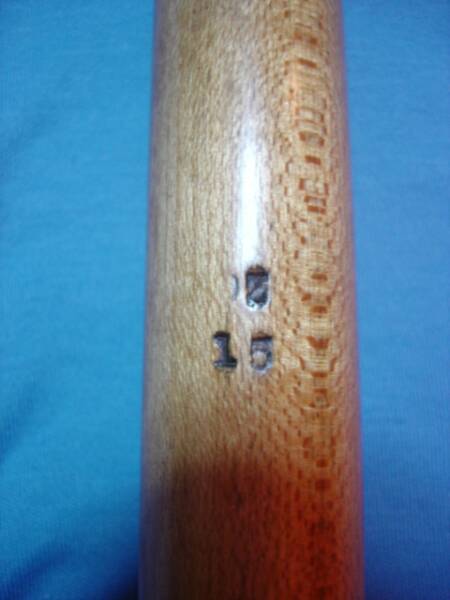
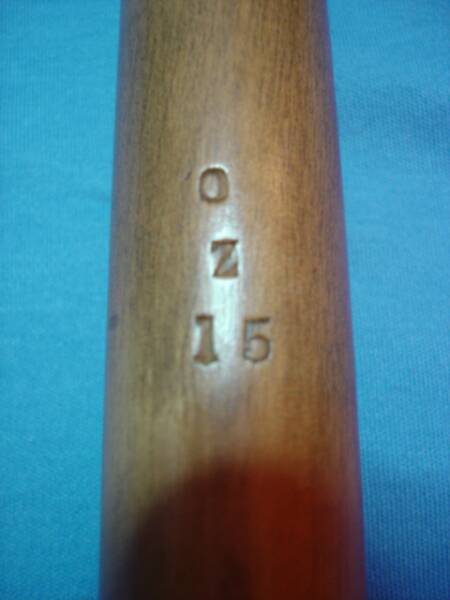
Peradon Weight Stamps - circa 1920s/1930s onwards
In the 1920s or 1930s, another type of weight stamp makes its appearance. This weight stamp is also shown in the picture to the right.
With this weight stamp, the manufactured weight of the cue sits above the letters "OZS" in a small, neat configuration which seems to have a fairly consistent size and style across all of the various cues on which it appears.
This type of weight stamp has been seen on a range of cues that began to appear in the 1920s and 1930s. These cues include the Tom Newman Champion Cue; the 29 Lindrum; and the 32 Lindrum.
We have also seen this weight stamp on a Howarth Nuttall Exhibition Cue, a Harry C Virr Special Amateur Cue, an International Cue, a Professional Champion Cue and a Joe Davis Champion Cue, commemorating the 138 break made by Joe Davis in March 1938.
It is unclear when this weight stamp ceased to be used. We believe that the 32 Lindrum was still being advertised for sale as late as the 1960s but, unfortunately, we have been unable to ascertain what type of weight stamp appeared on the cue during that period. It is a guess but we suspect that the weight stamp will have remained the same. None of the 32 Lindrums we have ever seen had a different weight stamp.
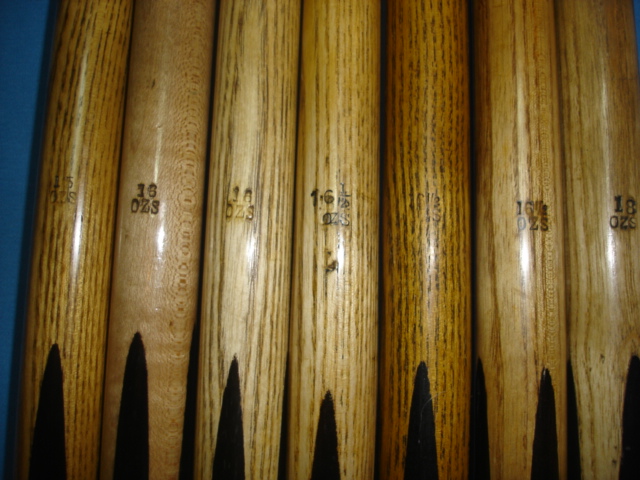
The Single Number Weight Stamp - circa late 1940s/1950s onwards
Another type of Peradon weight stamp has a very plain single number which appears upright on the shaft, as shown in the picture to the right.
This type of weight stamp has been seen on a series of cues which appeared after the end of the Second World War in 1945. These cues include:
- the Guide Dogs for the Blind Cue, which was released in conjunction with a series of exhibition matches to raise money for soldiers who had lost their sight during the Second World War;
- the 1953 Coronation Cue, which commemorates the 1953 coronation of Queen Elizabeth II; and
- a Joe Davis 146 Break Cue, commemorating Joe Davis' March 1950 snooker break.
There is another type of Peradon weight stamp which also has a single number. However, in this case, the number runs along the shaft.
A further variation is a similar weight stamp with the number followed by the letters "OZ", again running along the shaft. We have seen this type of weight stamp on a Joe Davis Champion Cue (147 break) and also on two Sidney Smith Tournament Cues. Each of these cues are believed to have been specially made by Peradon & Co for the purposes of two sports expos - one in the mid 1930s and the second in the 1950s.
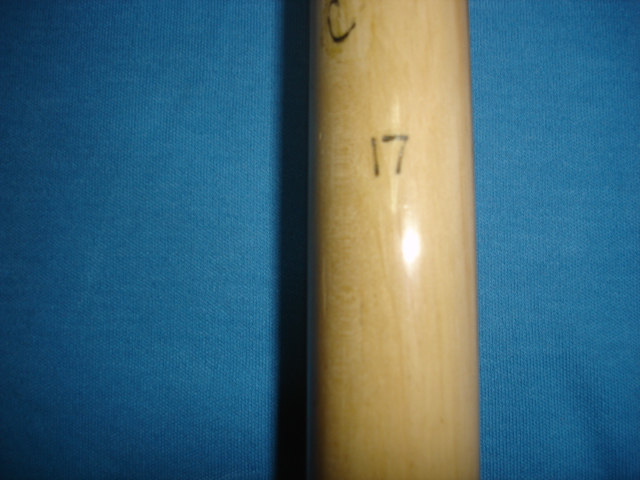
Ounces over Numbers - circa 1930s onwards
The weight stamp shown in the four pictures to the right is the most commonly seen Peradon weight stamp and, not surprisingly, it is associated with more modern Peradon cues.
In this weight stamp, the letters "OZ" appear above the manufactured weight of the cue.
This weight stamp appears on various types of cues that were probably manufactured during the period from the late 1930s and ending in the 1970s.
The first photo shows a group of 15 Peradon cues, all of which have this type of weight stamp. The next three photos show close ups of these weight stamps and identify the cues on which they appear.
One of these cues has a very good provenance. The cue was owned by a well-known Australian billiards identity who bought it as a young man and gave it to me a couple of years ago. We know the cue was purchased in Australia in 1945. It is almost certain that this cue would have been made before the Second World War as cues would not have been shipped from England to Australia during the Second World War.
We have seen this type of weight stamp on a vast range of Peradon-manufactured cues, which included: the Non-Pareil Cue; the Empire Match Cue; the Sidney Smith Tournament Cue; Horace Lindrum Champion Cues; Joe Davis Champion Cues; the Permac Champion Cue; and the Walter Lindrum World's Record Break Cue.
We believe that this type of weight stamp was probably used well into the late 1960s.
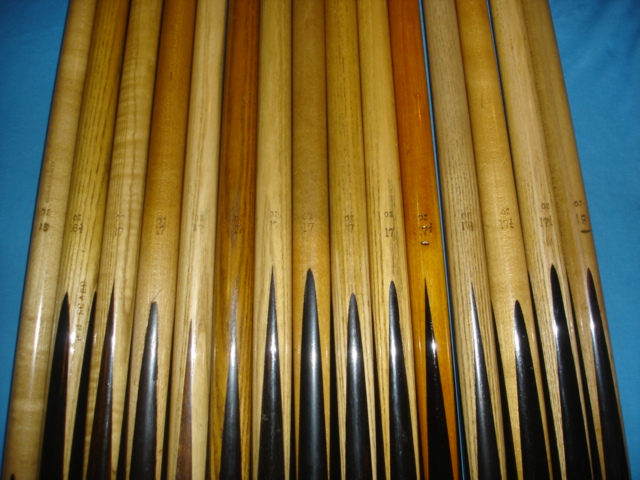
Numbers over Single Letter - circa 1960s onwards
The last Peradon weight stamp - the most modern one - is shown in the picture to the right.
This weight stamp is a slight variation from its predecessor. Like its predecessor, it has a plain single number. However, a single letter now appears below the number.
The single letter probably designates the person who made the cue. It would have been included for quality assurance purposes.
This type of weight stamp has been seen on a Walter Lindrum Club Cue, which was known to have been sold after the Second Wolrd War.
It is also commonly seen on Joe Davis 147 Break cues, which would have been manufactured after January 1955 when Joe Davis made the first perfect snooker break in a world snooker championship match. This type of cue was manufactured well into the 1970s.
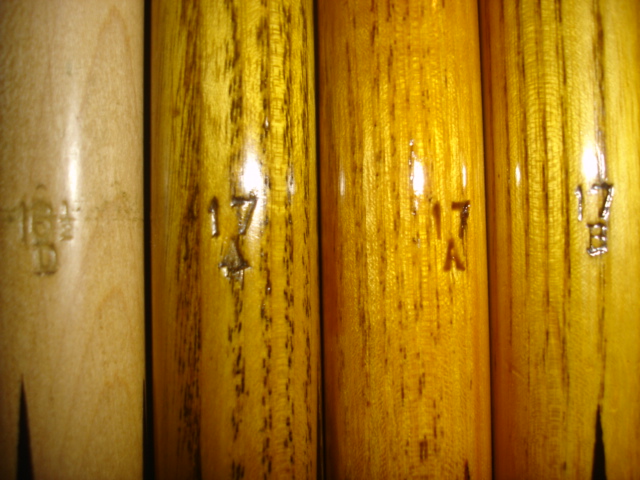
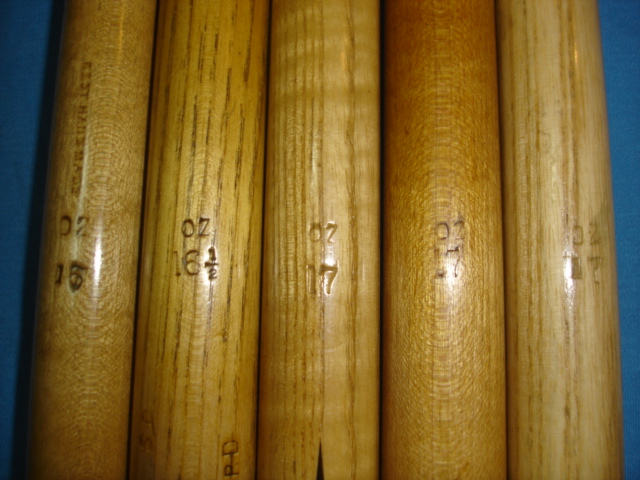
Sixth Type – Ounces over Numbers
Close Up of Cues (from left to right)
1. The Peall Record Cue – Picture Badge
2. Alec E Brown Gold Cup Cue
3. Alcock’s Special Cue
4. Jack Rea News of the World Tournament Champion Snooker Cue
5. Sidney Smith Tournament Snooker Cue
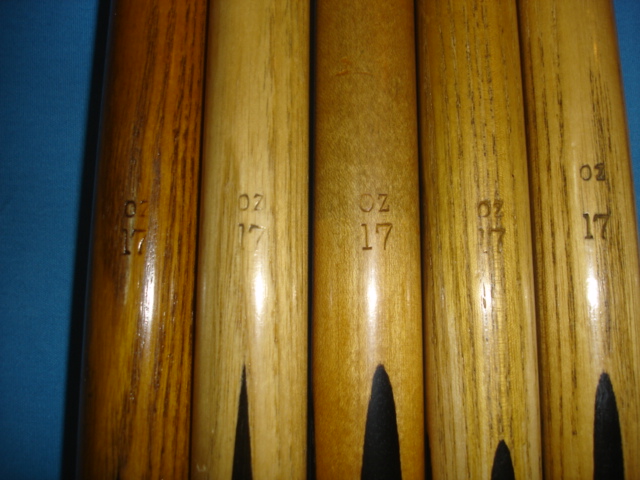
Sixth Type – Ounces over Numbers
Close Up of Cues (from left to right)
6. Alcock’s Special Cue
7. Alcock’s Special Cue
8. Alcock’s Champion Cue
9. Alcock’s Champion Cue
10. Alcock’s Champion Cue
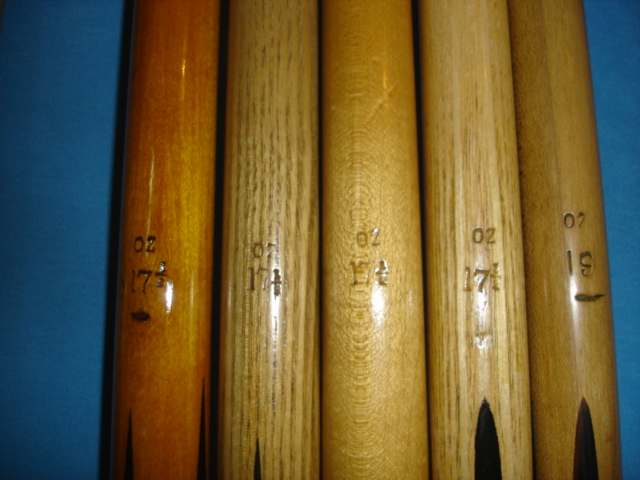
Sixth Type – Ounces over Numbers
Close Up of Cues (from left to right)
11. Alcock’s Special Cue
12. Alcock’s Special Cue
13. Horace Lindrum Champion Cue (Young Portrait)
14. Alcock’s Champion Cue
15. The All Black Special Cue
Other Comments
This article covers the most common weight stamps seen on Peradon-manufactured cues. To complete the picture, we should mention that some firms appear to have bought Peradon cues, which were made with their own style of weight stamp.
One example is W.A. Camkin. At least some Camkin cues were made by Peradon. These cues had a weight stamp that comprised a single number, which designated the manufactured weight of the cue. This number was slighly smaller than the single number weight stamp shown above. On later Camkin cues, a small red-coloured square sticker was added below the weight stamp. This sticker carried the letter "B".
Another example is Murtons of Newcastle. Murtons were somewhat unique in that they purchased woods and then supplied those woods to Peradon in order to make Murton cues. The weight stamp on the cues made by Peradon for Murtons was like the weight stamp on the cues made by Peradon for Camkins - i.e., a small single number, designating the manufactured weight of the cue.
